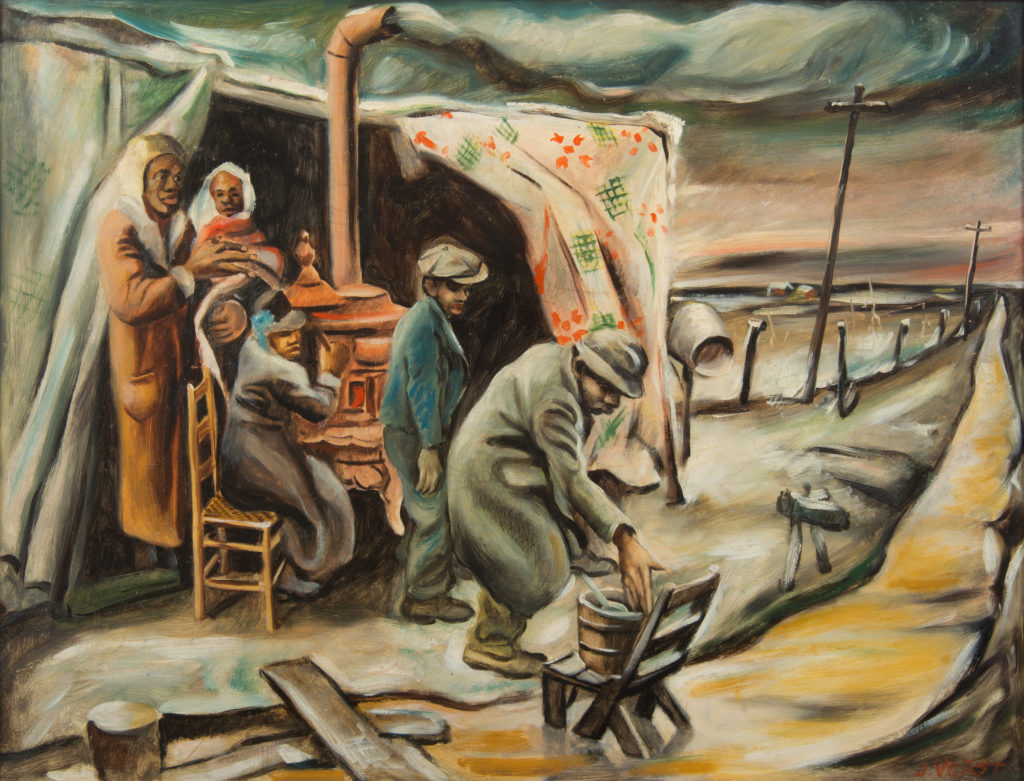
The stock market crash of 1929 caused mass unemployment, homelessness, and poor quality of living nationwide for Americans. On top of that, a severe drought hit the Midwest, causing a string of dust storms known as the Dust Bowl. With the Great Depression looking more and more bleak in 1933, morale was low and Franklin D. Roosevelt (FDR) was elected as president in hopes of curbing the economic decline and getting Americans back on their feet. With his famous “New Deal” plan, President Roosevelt started the Works Progress Administration (WPA) overseeing the many programs created for social services, producing jobs, and building the country back up. One of these programs was called the Federal Art Project (FAP), created by Roosevelt in 1935 to benefit struggling artists – considering them important laborers – all over the country.
The Works Progress Administration
In the 1947 post-war noir film Crossfire, produced by RKO Pictures and directed by Edward Dmytryk, one character asks another, “What sort of an artist are you?” The man answers, “I did a mural once in a post office for the WPA.” The other replies, “Oh, a lot of fine artists came from there.” This true fact may go over the head of audiences today, but viewers back then knew exactly what these characters were talking about. Even if, after a brutal World War II, the Great Depression seemed long ago.
The WPA, through the FAP, provided many resources for the artists of the Great Depression, employing hundreds of thousands of artists from 1935 until 1943, shortly after the United States entry into World War II. These artists created paintings, sculptures, photographs, and more. Their works depicted American labor and industry from farms to small towns to the liveliness of urban life, where Art Deco architecture reached for the clouds.
Still unprecedented for an American president before and after the Great Depression, Roosevelt provided artists with the funding and resources to create lasting works of art. In return, these artists worked to promote Roosevelt’s cause while also glorifying the American workersusa and the industrial growth of early 20th-century America.
Thomas Hart Benton and Rural America
Thomas Hart Benton was one of the major beneficiaries of the WPA. Along with Grant Wood and John Steuart Curry, he was a leader of the Regionalist movement. His dynamic compositions – usually lithographs and murals – consisted mostly of rural, agricultural landscapes. Benton sought to unveil the “real” America found in the Midwest, believing the foundations of the country and its individualistic values lay in the simplicity of the pastoral.
Industrial Growth in Paintings
Most paintings of Great Depression art, like the two presented here, featured the industrial growth of America. Workers repair a pipe with an industrial site in the background of Robert Gilbert’s geometrical Industrial Composition. Ray Strong’s Golden Gate Bridge shows the early developments of the Golden Gate Bridge in the San Francisco Bay. His painting emphasizes the challenge of the bridge’s construction through the scale of the bay landscape. President Roosevelt was so pleased with the painting’s depiction of America’s ability and growth that he hung it in the White House.
Diversity in the WPA
While the subjects of Great Depression art usually consisted of white working Americans, the diversity of artists funded by the WPA was robust. Artists such as Doris Lee, Elizabeth Olds, and Georgia O’Keeffe contributed works for the WAP. Dox Thrash, a Black painter and printmaker, depicted a workers’ strike in his 1940 watercolor, Untitled (Strike). The leader of the protest dominates the frame, showing that Black Americans had just as prominent a role in the economic turmoil of the past decade. However, to the left, a man in a window with a hand on his face also suggests that not all Americans approved of these gatherings.
This period of American history is full of rich artworks depicting the Great Depression and its affect on all Americans. In fact, when it comes to the history of art in the United States, there is still nothing quite like the 1930s and early 1940s. As the American painter Jacob Lawrence once said, “The greatest exposure for the greatest number of people came during this period of government involvement in the arts.”
Though many struggled and suffered, Great Depression art, with help from government programs, helped to portray the resilience of Americans. John Cunning’s Manhattan Skyline perfectly captures the stalled yet steady growth of the country through skyscrapers towering over warehouse workers.
